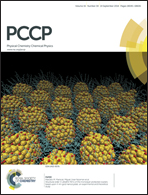Local structure and lithium mobility in intercalated Li3AlxTi2−x(PO4)3 NASICON type materials: a combined neutron diffraction and NMR study†
Abstract
The structural features of intercalated Li3AlxTi2−x(PO4)3 compounds, with x = 0 and 0.2, have been deduced by Rietveld analysis of neutron diffraction (ND) patterns recorded between 100 and 500 K. The Li insertion decreases the symmetry from R![[3 with combining macron]](https://www.rsc.org/images/entities/char_0033_0304.gif) c to R
c to R![[3 with combining macron]](https://www.rsc.org/images/entities/char_0033_0304.gif) in analyzed compounds. In pristine Li1+xAlxTi2−x(PO4)3 samples, Li occupies mainly six-fold M1 sites at ternary axes; but in lithiated Li3AlxTi2−x(PO4)3 samples, Li is located near M2 positions at M3/M3′ four-fold coordinated sites. In both cases, Li arrangement minimizes electrostatic Li–Li repulsions. The insertion of lithium resulted in the reduction of Ti4+ to Ti3+ that shifts 7Li, 27Al and 31P MAS-NMR resonances towards more positive chemical shifts, improving the resolution of different sites. The detection of twelve components in 7Li MAS-NMR spectra recorded at room temperature suggests the location of Li+ ions at three-oxygen faces that define M2 cavities. From 7Li MAS-NMR spectra, the occupancy of sites and mobility of lithium were investigated in the temperature range 100–500 K. The correlation between structural information, deduced by neutron diffraction, and lithium mobility, deduced by NMR spectroscopy, provides new insights into structural factors that affect lithium mobility in materials with NASICON structure.
in analyzed compounds. In pristine Li1+xAlxTi2−x(PO4)3 samples, Li occupies mainly six-fold M1 sites at ternary axes; but in lithiated Li3AlxTi2−x(PO4)3 samples, Li is located near M2 positions at M3/M3′ four-fold coordinated sites. In both cases, Li arrangement minimizes electrostatic Li–Li repulsions. The insertion of lithium resulted in the reduction of Ti4+ to Ti3+ that shifts 7Li, 27Al and 31P MAS-NMR resonances towards more positive chemical shifts, improving the resolution of different sites. The detection of twelve components in 7Li MAS-NMR spectra recorded at room temperature suggests the location of Li+ ions at three-oxygen faces that define M2 cavities. From 7Li MAS-NMR spectra, the occupancy of sites and mobility of lithium were investigated in the temperature range 100–500 K. The correlation between structural information, deduced by neutron diffraction, and lithium mobility, deduced by NMR spectroscopy, provides new insights into structural factors that affect lithium mobility in materials with NASICON structure.


 Please wait while we load your content...
Please wait while we load your content...